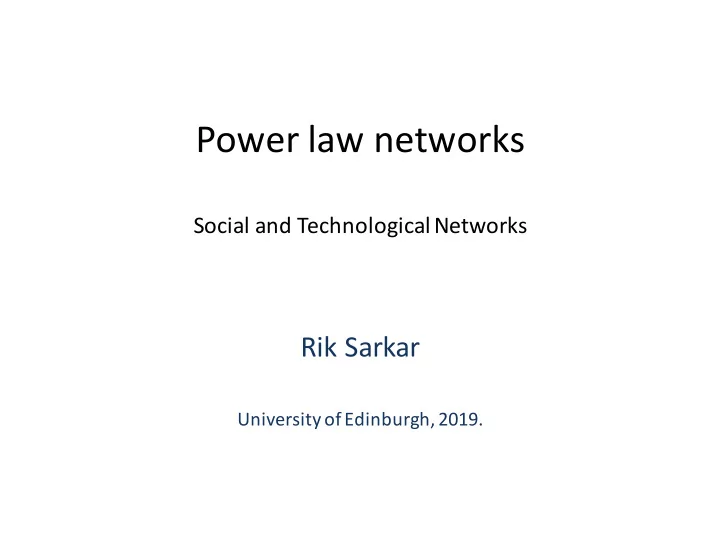

Power law networks Social and Technological Networks Rik Sarkar University of Edinburgh, 2019.
Degree distribution • A way of characterizing networks • More complex than single numbers • Many standard networks are known to have “standard” degree distributions • Gives ways to incorporate notions of “popularity” and understand them
Degree distribution • As a function of k, what fraction of pages in the network have k links? • A histogram • What does it look like in a random graph?
Degree distribution of a random graph • Probability that a node has degree k is: – Given by binomial distribution: ✓ n − 1 ◆ p k (1 − p ) n − 1 − k k Probability that others are not chosen Probability that Possible sets of all k are chosen k edges
Degree distribution in a random graph • Probabilities fall off really fast away from the peak – Exponentially fast with k – Very low and high degree are very very unlikely
Degree distribution in www • Suppose we take a real network like the world wide web, and compute degree distribution. What does that look like? • Let’s try.
Degree distribution in www • For www snapshots, degree distribution follows approximately 1 k 2
Power law networks 1 • With degree distribution k α • For some constant α
What do power law networks mean • Most nodes have a low degree • There are several hubs with high degree – Heavy tail – Probability drops polynomially • Slower than exponentially Hubs Most nodes
Hubs in power law networks • Highly connected people/entities • Critical in information dissemination • Causes the network to have small diameter • Examples – www, internet.. – Social networks – Collaboration networks
Log log plots • On ipython notebook
Log log plots for power law are nice and straight
Be careful with log log plots • The “straight” part needs to extend quite a few orders of magnitude for the pattern to be significant • Fitting the straight line to determine the right coefficient alpha is not trivial due to non- linear nature of data • Beware: log-normal distributions can look similar to power law.
Mean degree in a power law distribution • The mean is finite iff α > 2 – (On an infinite graph) • On the www α is slightly larger than 2
Model of power law networks • We want a model that can be used to create power law networks • Preferably one that mimics creation of actual power law networks like www – Gives us some idea of how these networks were created
Preferential attachment mechanism • Idea: older and established (popular) sites are likely to have more links to them (yahoo, google…) • So how about: When a new page arrives, it links to older pages in proportion to their popularity • When a new link is created on a new page, randomly to older pages with probability of hitting a page x proportional to current popularity of x (number of links to x)
Preferential attachment model • Takes a parameter p in [0,1] • On a new page, create k links as follows: • When creating a new link: • With probability p – Assign it with preferential attachment mechanism • With probability 1-p – Assign it with uniform random probability to any existing page
Preferential attachment model • Takes into consideration that popularity is not the only force behind link creation. • The randomly assigned links model other reasons for link creation. • Can be proven to produce power law. see [Kempe lecture notes, 2011] • Produces same exponent as www for p~0.9 • Let’s see in the data
Power law often appears in other places • Popularity of books • Popularity of people, songs, …. • Preferential attachment & power law are often a signature of artificial selection and popularity
Other reasons for power law • Optimization: – Power law found in linguistics (word lengths): most frequent words are short • Mandelbrot, Zipf : emerges from need for efficient communication • Random processes: – Press space with probability p, else press a random letter key – This will produce a power law distribution of word lengths
Recommend
More recommend